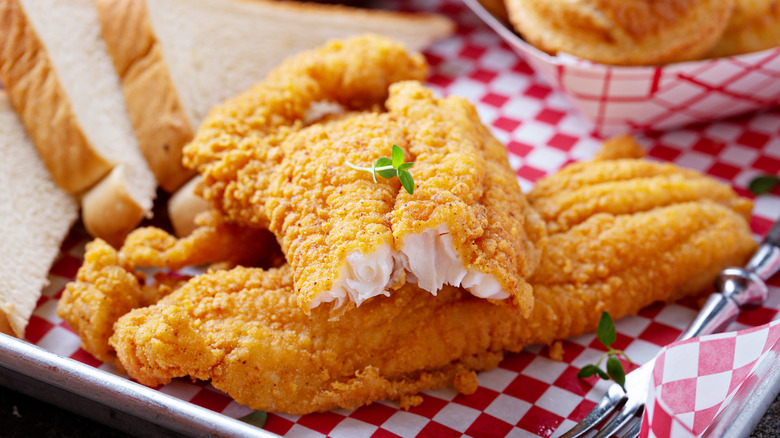Why You Should Think Twice About Eating Leftover Catfish
Some rules about seafood are very clear cut. Few foods can top it when fresh, for example, while few foods go bad faster or more spectacularly. But don't make the mistake of thinking nuance doesn't matter when it comes to seafood, as there are several differentiations in type that should definitely be taken note of by home cooks. And no, we're not talking about the difference between fish and shellfish, but rather about the one between oily and non-oily fish.
Fish like trout, salmon, sardines and tuna are perhaps best known for their healthy omega-3 fatty acids, but as BBC Food notes, these fish tend to be very rich in natural fats and oils throughout their bodies — hence the designation as "oily." This distinguishes them from white fish, whose oils are almost entirely concentrated in their livers. Non-oily white fish like cod, sole, and catfish have a tendency to dry out easily when cooked, observes Help With Cooking, and thus are often heavily aided with the moisture from basting, marinades, and sauces.
It's also why, according to Southern Living, you should definitely think twice before reheating a non-oily white fish like catfish.
Tips for reheating catfish
Catfish can be cooked in a variety of ways. You can bake it, you can grill it, you can sauté it ... heck, you can even make catfish nuggets. But the classic Southern style variation is, of course, to fry it with breading that helps to keep the moisture in. Southern Living is absolutely right that you should think twice before reheating catfish due to its non-oily nature. Depending on the preparation, it's very easy to dry out on the first go-round, much less the second. But that doesn't necessarily mean you shouldn't do it if the fish is still in good condition — just exercise caution when reheating.
Let the catfish come to room temperature after removing it from the refrigerator, and avoid the microwave. For fried fish, First for Women recommends preheating an oven to 350 degrees, and then cooking it for 10 to 15 minutes. Or, if you don't want to spend that much time cooking, you can heat up a skillet on high and add oil first, then the catfish, and within three minutes it should be ready to eat. Just make sure to bring the catfish to an internal temperature of 145 degrees, the U.S. Department of Agriculture recommendation for a safe minimum temperature to kill any potential bacteria.

